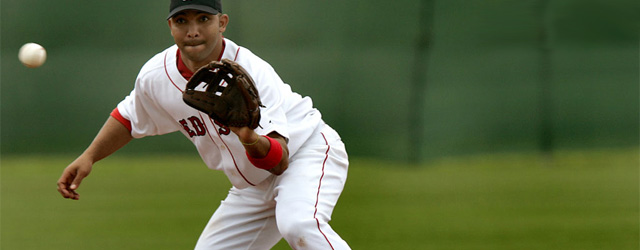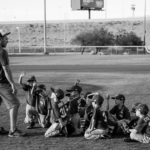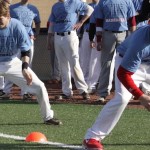Part 2 in a series discussing 1st and 3rd situations. For Part 1, click here.

First and third situations can present a good opportunity for the offensive team to sneak a run across the plate. Double steals, walking leads off of first, and intentional rundowns are just a few of the many ways teams can try to catch the defense off guard. That’s why it’s important to have quality practices that work on first and third situations (and other situational baseball) from the defensive side of the ball. First and third situations are unique in that no matter what play is called, the situation is fluid and the movements of each runner can dictate where the play will be. In Part 1, we looked at just getting an out by throwing through to second base. Now, let’s look at preventing the runner on third base from scoring.
Offensive Strategy – Score a Run
When the offensive team calls a basic steal of second base, they are usually trying to accomplish one of two things. Either they are trying to stay out of the double play by getting the runner from first base to second base, or they are attempting to draw the catcher’s throw to second base in hopes of giving the runner on third a better chance at scoring. When the game is close, and the offensive team needs a run, you can bet they are going to try to plate the runner on third by drawing the defense’s attention to the runner stealing second base.
Throwing to the Shortstop
As a coach, you’ll want to call this play when preventing the runner on third from scoring is a priority. Usually, the game is close, so the effect of that run scoring could have disastrous effects for your team. The runner on first does not matter, so if he wants to take second base, then we are going to let him have it so we can cut down the runner trying to score.
Catcher’s Responsibilities
The catcher has a simple task here. After he receives the pitch, he should pop up just like any other throw down to second. However, instead of throwing all the way down to second base, he will be throwing directly to the shortstop who will be cutting off the throw on the infield grass.
There is no need for the catcher to even check the runner at third base before the throw. We want the runner to believe that we have forgotten about him and are throwing through to second base. After the throw, the catcher should expect the shortstop to either throw the ball directly back to him, or prepare to be in a rundown situation.
Middle Infielders’ Responsibilities
The shortstop is the primary component to this play, and as soon as he sees the pitch hit the catcher’s mitt, he should be breaking straight toward the infield grass. He should not be moving toward a position in front of second base, but rather he should be sprinting toward a position he would be in if the infield was playing in. This will give him a shorter throw to both home and third, depending on how the play develops. The shortstop should expect the ball to be thrown to him no matter what, and he should be aware that the play might develop one of three ways:
- The runner may break straight for home, in which case, the shortstop will need to get rid of the ball quickly and throw it home to cut the runner down.
- The runner may break for home, then stop and try to get back to third when he realizes he has no chance of scoring. If this happens, the shortstop needs to get the ball to the third baseman (who should be covering his bag) as quickly as possible for the tag.
- The runner may freeze in the baseline. If this happens, the shortstop should force the runner to make a decision by running directly at him with the ball held up in his throwing hand. Once the runner decides to run toward third or home, the shortstop should get rid of the ball to the respective base.
The second baseman needs to break for second base as if he is covering for the throw from the catcher. He needs to make both runners and base coaches believe the throw is going to second base.
Pitcher and First Baseman’s Responsibility
After delivering the pitch, there is no need for the pitcher to become a spectator. He should make his way behind home plate to act as a backup for a bad throw or to help in a situation where a rundown may develop.
This goes for the first baseman as well. We do not care about the runner on first advancing to second, so there is no need to stay at first base. The first baseman should be behind home plate as a backup for bad throws and rundown situations.
Keep the Run from Scoring
Remember, this is just one play that can be implemented when trying to prevent the run from scoring and getting the lead runner out. If we cannot get the runner out, we at least want to prevent him from scoring by keeping him at third. The ideal situation would have the play end with the runner on third called out and a runner now on second. By no means do we want the run to score and the runner on second to be safe. So, if we cannot get the lead runner out, we want to at least keep him on third.







One response to “Defending 1st & 3rd Situations: Throwing to the Shortstop”
[…] Parts One, Two, and Three we thoroughly covered what the offense is trying to accomplish during a first and third […]